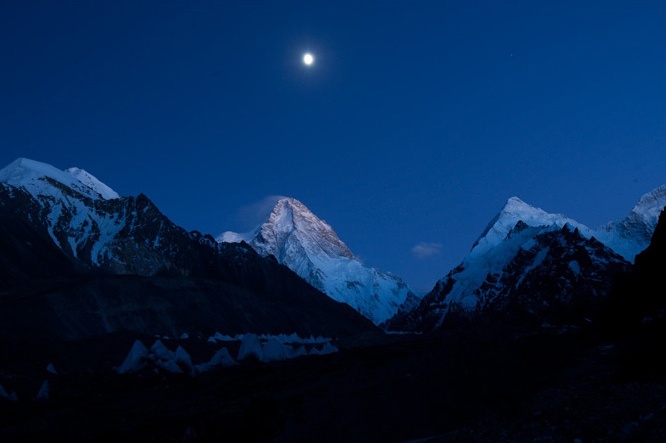National Geographic, April 2012: K2 - Danger and Desire On The Savage Mountain
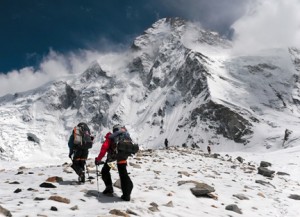 Tomorrow Is Our Day
Tomorrow Is Our Day
Here at last was a morning that gave them hope: Monday, August 22, Camp IV, 7,950 meters. The gales were gone, the snow had quit, the sky ran blue and cloudless to the black edge of space.
For most of July and half of August the six members of the International 2011 K2 North Pillar Expedition had been shuttling up and down the seldom attempted North Ridge of the world’s second highest peak. Theirs was the only party on the remote Chinese side of K2, the Karakoram Range giant that rises 8,611 meters (28,251 feet) on the China-Pakistan border. The mountaineers were climbing the ridge (as it is commonly referred to, even though “ridge” understates the steepness of the terrain) without bottled oxygen or high-altitude porters.
What the team lacked in numbers it made up for in experience. The two climbers from Kazakhstan—Maxut Zhumayev, 34, and Vassiliy Pivtsov, 36—were making their sixth and seventh attempts to summit K2, respectively. Dariusz Załuski, a 52-year-old Polish videographer, was a veteran of three attempts. Tommy Heinrich, a 49-year-old photographer from Argentina, had two K2 expeditions on his résumé but had also failed to summit.
 Most notable was Gerlinde Kaltenbrunner, a 40-year-old, dark-haired former nurse from Austria who was on her fourth trip to K2. If she succeeded this time, she would become the first woman in history to climb without supplemental oxygen all 14 of the world’s peaks that exceed the mystique-endowed height of 8,000 meters (26,247 feet). She was leading the expedition with her husband, Ralf Dujmovits, 49, who had already climbed all of the 8,000-meter peaks (all but one without bottled oxygen) and was the foremost high-altitude mountaineer in Germany. He had reached the top of K2 from the Pakistani side on his first try, in July 1994.
Most notable was Gerlinde Kaltenbrunner, a 40-year-old, dark-haired former nurse from Austria who was on her fourth trip to K2. If she succeeded this time, she would become the first woman in history to climb without supplemental oxygen all 14 of the world’s peaks that exceed the mystique-endowed height of 8,000 meters (26,247 feet). She was leading the expedition with her husband, Ralf Dujmovits, 49, who had already climbed all of the 8,000-meter peaks (all but one without bottled oxygen) and was the foremost high-altitude mountaineer in Germany. He had reached the top of K2 from the Pakistani side on his first try, in July 1994.
It had taken 42 days for the six climbers to establish several camps connected by thousands of feet of rope fixed across a route that included everything from vertical rock and ice to avalanche-raked slopes of chest-deep snow. They pushed themselves to break trail in heavy snow, haul gear, shovel out campsites, pitch tents, melt ice. Many times they relinquished their gains on the mountain, going down to sleep at the lower elevation of Advanced Base Camp, at 4,650 meters on the K2 North Glacier.
On August 16 they set out on what would be their first and only real chance for the summit. The snow that had been falling for much of the summer had started again. They reached Camp I, at the foot of the ridge, that day; avalanches roared and more than a foot of snow fell overnight. They waited there for a day, hoping the snow on the slopes above would come down before they continued their ascent.
On August 18 at 5:10 a.m. they decided to push ahead to Camp II. Every extra ounce was a burden; to save weight, Gerlinde left her journal in the tent. Two avalanches had already swept over their route up a long gully. Around 6:30 a.m. Ralf stopped. So precarious were the snow conditions he could no longer ignore his gut feelings.
“Gerlinde, I am going back,” he said.
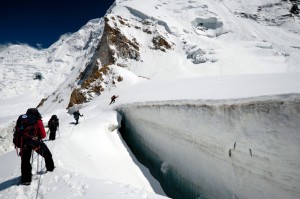 Since the couple had been climbing together they had made a pact that neither would stand in the other’s way if one wanted to continue and the other did not. Barring injury or ill health, they were responsible for themselves. On Nepal’s Lhotse in 2006—just one of several examples—Gerlinde had climbed on alone for 20 minutes after Ralf had been deterred by fresh snow over the blue ice of the summit couloir, before she too turned back. She was, as he acknowledged, still brimming with wagnis—a German word meaning “daring.” Having never been to the top of K2, she was willing to take risks that Ralf, who had, was not. She coped with fear differently too. Where he relished how the sensation of fear in his stomach revealed the margins of his ability and compelled him to pay attention, Gerlinde strove to block out fear with the quiet calm that possessed her when she was absorbed in what she had to do. If she kept herself completely focused on the task at hand, she didn’t feel afraid.
Since the couple had been climbing together they had made a pact that neither would stand in the other’s way if one wanted to continue and the other did not. Barring injury or ill health, they were responsible for themselves. On Nepal’s Lhotse in 2006—just one of several examples—Gerlinde had climbed on alone for 20 minutes after Ralf had been deterred by fresh snow over the blue ice of the summit couloir, before she too turned back. She was, as he acknowledged, still brimming with wagnis—a German word meaning “daring.” Having never been to the top of K2, she was willing to take risks that Ralf, who had, was not. She coped with fear differently too. Where he relished how the sensation of fear in his stomach revealed the margins of his ability and compelled him to pay attention, Gerlinde strove to block out fear with the quiet calm that possessed her when she was absorbed in what she had to do. If she kept herself completely focused on the task at hand, she didn’t feel afraid.
But now, in the gully above Camp I, despite their agreement, despite knowing the delay might cost her a chance to reach the summit, Ralf begged his wife to come down with him. His composure deserted him. “Ralf was yelling that the route is very, very avalanche prone. He was shouting desperately,” Maxut said later in a video on his website, “and Gerlinde shouted in return that now is the moment when the fate of the climb will be decided. If we turn around today, on the 18th, we are not making the period of good weather.”
“I was really afraid I would never see her again,” Ralf explained later.
In what was her most anguished moment of the climb so far, Gerlinde watched as Ralf distributed his group gear to the rest of the team and descended into the mist. And then, in what may be the premier example of her tenacity and will, she returned to the task at hand. “It’s not that I was indifferent to the risk,” she said afterward. “But my gut feeling was good.”
As Ralf had feared, the snow on the slope began to rip loose, three small slides in succession set off by Maxut, Vassiliy, and Gerlinde, who were out front breaking trail. The biggest hit Tommy, climbing almost 200 feet below; it knocked him upside down and stuffed his nose and mouth. Only the fixed rope, taut as a cello string, kept him from being flushed off the mountain. He was able to dig himself out, but the slide had refilled the broken trail, and eventually he too turned back.
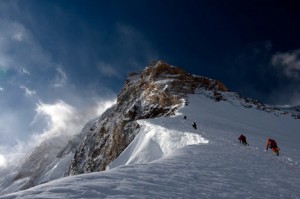 So now they were four: Gerlinde, Vassiliy, Maxut, and Dariusz. The job of breaking trail was Sisyphean—worse really, because they couldn’t pretend they hadn’t volunteered for the punishment. Sweep the snow aside, crack the crust with your knee, compact what’s underneath, step up, slip back. Repeat and repeat and repeat. After 11 hours they set up a bivouac at Shoulder Depot Camp, below Camp II, and spent a miserable night crammed into a two-person tent. The following day they negotiated the most difficult sections of the ridge and reached Camp II, at 6,600 meters, where they changed into down suits. On Saturday, August 20, they slogged on to Camp III, arriving in the afternoon, exhausted, chilled to the bone. They drank coffee with honey and warmed their hands and feet over their gas stoves. All night the hoarfrosted tent walls snapped and shuddered in the wind.
So now they were four: Gerlinde, Vassiliy, Maxut, and Dariusz. The job of breaking trail was Sisyphean—worse really, because they couldn’t pretend they hadn’t volunteered for the punishment. Sweep the snow aside, crack the crust with your knee, compact what’s underneath, step up, slip back. Repeat and repeat and repeat. After 11 hours they set up a bivouac at Shoulder Depot Camp, below Camp II, and spent a miserable night crammed into a two-person tent. The following day they negotiated the most difficult sections of the ridge and reached Camp II, at 6,600 meters, where they changed into down suits. On Saturday, August 20, they slogged on to Camp III, arriving in the afternoon, exhausted, chilled to the bone. They drank coffee with honey and warmed their hands and feet over their gas stoves. All night the hoarfrosted tent walls snapped and shuddered in the wind.
They had been promised better weather by a satellite-phone forecast Ralf passed along over the radio from Advanced Base Camp. The break finally arrived on Sunday, August 21, lifting everyone’s spirits and helping to carry the team to Camp IV. They were now at nearly 8,000 meters, in the so-called death zone, where the body is unable to acclimatize to the oxygen-depleted air, cognition becomes impaired, and the simplest tasks can take forever. They spent the afternoon sharpening their crampons and melting snow. Toward evening they stood outside their tents, pitched in a notch of rock above an appalling void that plunged nearly two miles to the glacier below. Two thousand feet above lay the glistening white mantle of the summit, untouched since 2008, when 11 climbers died in one of the deadliest mountaineering episodes in the history of K2.
“There was a moment when we all started to get nervous, in a good way,” Gerlinde said later. “We touched each other’s hands and looked at each other in the eyes and said, ‘OK, tomorrow is our day.’”
A Passion for Climbing
K2 has a singular place in high-altitude mountaineering. Though 784 feet lower than Mount Everest, it has long been known as the mountaineer’s mountain. The sharp triangle of its silhouette and height above the surrounding terrain not only define the archetypal image of a mountain but, as a practical matter, also make K2 far more difficult and dangerous to climb. As of 2010 Everest had been summited 5,104 times; K2, just 302. Roughly one K2 climber has died for every four who’ve succeeded.
 After the first attempts by British and Italian climbing teams in the early 1900s, American parties tackled K2 in 1938, 1939, and 1953. Charles Houston and Robert Bates titled their account of their 1953 expedition K2: The Savage Mountain. The characterization has been invoked so often over the years you’d think the moods of K2 reflected some personal antipathy toward mountaineers petitioning for its favor rather than the random dynamics of the physical world. In 1954 K2 was finally “conquered” by a large Italian expedition that put two men on the top via the now standard summit route on the Pakistani side of the mountain.
After the first attempts by British and Italian climbing teams in the early 1900s, American parties tackled K2 in 1938, 1939, and 1953. Charles Houston and Robert Bates titled their account of their 1953 expedition K2: The Savage Mountain. The characterization has been invoked so often over the years you’d think the moods of K2 reflected some personal antipathy toward mountaineers petitioning for its favor rather than the random dynamics of the physical world. In 1954 K2 was finally “conquered” by a large Italian expedition that put two men on the top via the now standard summit route on the Pakistani side of the mountain.
As for Gerlinde Kaltenbrunner, the mountaineer’s mountain had made an indelible impression on her when she first glimpsed it from nearby Broad Peak in 1994 at age 23. “I was fascinated by its shape,” she said, “but I didn’t dare imagine myself ever climbing on it.”
Gerlinde, the fifth of six children, grew up in a Roman Catholic family in Spital am Pyhrn, a mountain village of about 2,200 people in central Austria. Her father, Manfred, worked in the local quarries; her mother, Rosamaria, was a cook in a youth hostel. Gerlinde idolized her big sister, Brigitte, ten years her senior. She was mad for sports: swimming, biking, skiing. There wasn’t much money in the house; Gerlinde didn’t see a movie in the cinema until she was 17.
She attended a school for sports, including ski training, where she discovered she was a good skier but not topflight. More upsetting was when supposedly close friends expressed resentment if she happened to do better in a race. The experience of early school rivalries soured her on competition and shaped her later reluctance to view herself as a contestant vying for records against other female mountaineers.
It was at church, not school, that her passion for climbing was awakened. In a country where most major mountains have crosses on top, it shouldn’t be surprising that Erich Tischler, the local Catholic priest, wore climbing knickers under his cassock and, if the weather was good, would shorten his Sunday sermon to hasten his flock to the hills. Gerlinde served as an altar girl, attending Mass with her boots in her rucksack. Father Tischler led her on her first hike, at age seven, and on her first technical roped ascent, of Sturzhahn Mountain when she was 13.
After her parents’ marriage ended in divorce in 1985, her relationship with her mother was strained. Gerlinde, then 14, moved out. She lived with her sister Brigitte and eventually followed her into the nursing profession. By 20 Gerlinde had a job at a hospital in Rottenmann, a small town about 15 miles from Spital am Pyhrn. She was happy, near her family, but independent. On weekends she skipped off to the local alps to climb. The appetite for adventure, which had always set her apart from her family, led her to the Karakoram Range in 1994. On Broad Peak in Pakistan she abandoned her bid for the summit as the weather worsened, then changed her mind, and finally reached the forepeak, some 20 meters lower than the 8,051-meter summit, which lay at the far end of a long ridge. (She would return to summit in 2007.) She was elated but, having seen the body of a climber who’d died on the mountain, was also perplexed. “It cannot be that happiness, joy, and death are so closely linked together,” she wrote in her journal.
Back home, Gerlinde saved money and cobbled together vacation days for trekking and climbing trips to Pakistan, China, Nepal, Peru. After her first expedition her father said, “OK, one is enough. You don’t have to do any more.” After the second he said, “Now you have two. That’s enough.”
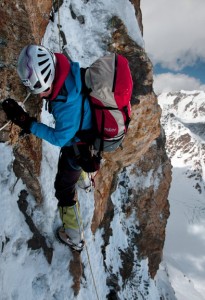 “His wish was to see me get married and have a family,” Gerlinde recalls. But she had known in her early 20s that children were not in her cards. She showed her father pictures and tried to explain the infusion of energy and happiness she felt in the mountains. There were risks of course, but nursing had taught her that death was part of life. And for perspective, she had only to look at the losses faced by Brigitte, who had already buried three husbands. Bad things could happen anytime, anywhere.
“His wish was to see me get married and have a family,” Gerlinde recalls. But she had known in her early 20s that children were not in her cards. She showed her father pictures and tried to explain the infusion of energy and happiness she felt in the mountains. There were risks of course, but nursing had taught her that death was part of life. And for perspective, she had only to look at the losses faced by Brigitte, who had already buried three husbands. Bad things could happen anytime, anywhere.
In 1998 Gerlinde climbed Cho Oyu, near the Nepal-China border, her first true 8,000-meter summit. Four years later, in 2002, she reached her third 8,000-meter summit, the top of 8,163-meter Manaslu in Nepal. In base camp she met Ralf Dujmovits, then 40 and at the peak of his celebrity, having starred in a live televised ascent of the north face of the Eiger in the Swiss Alps that was watched by millions of people. They got along like a pair of swans and broke trail together.
For more than 20 years women had been making inroads in the male domain of high-altitude mountaineering but were still frequently treated with condescension. In 2003, still acclimatized by an unsuccessful attempt on Kanchenjunga, Gerlinde flew to Pakistan to try the Diamir Face of the 8,126-meter Nanga Parbat. Above Camp II she found herself breaking trail in a single file with six male climbers from Kazakhstan and one from Spain. Her presence was not mentioned when the leader reported on the radio that seven climbers were heading up to Camp III. When she worked her way to the front of the line to take her turn breaking trail, she was nudged aside. Misguided chivalry? Arrogant disdain for her abilities? She wasn’t sure but went politely to the back of the line. When she had worked her way to the front again and one of the male climbers tried to wave her away a second time, she’d had enough. She took off, bulldozing her way up the unbroken slope without stopping. She plowed the path all the way to Camp III. The gob-smacked climbers in her wake nicknamed her “Cinderella Caterpillar” for the trail-breaking machine that had appeared in their midst.
She was the first Austrian woman to summit Nanga Parbat, the mountain known for the first ascent by the legendary Austrian climber Hermann Buhl in 1953. Her success on the 50th anniversary of Buhl’s audacious feat attracted notice in climbing magazines and gave her the impetus to make a profession out of her passion. Over the next two years she added Annapurna I, Gasherbrum I, Gasherbrum II, and Xixabangma Feng to her résumé. She now had climbed 8 of the 14 highest peaks. In January 2006 the German magazine Der Spiegel dubbed her “queen of the death zone.” The image of a haughty monarch reigning over life and death had little to do with the actual character of a sensitive, unselfish woman (in base camp on K2 Gerlinde tried to see if a pair of sunglasses would relieve the distress of a snow-blind sheep), but it did wonders for her lectures ticket sales, impressed sponsors, and secured her career as a professional mountaineer.
That spring of 2006, after she too had turned back on Lhotse, she found Ralf waiting in their camp at 7,250 meters. It was an unusually warm night; as they lay in their sleeping bags outside the tent under the stars with a bed of clouds blanketing the earth below and bolts of distant lightning blazing on the face of Everest, Ralf asked Gerlinde to marry him.
“It was not your typical first three months of marriage,” Gerlinde says. The newlyweds spent the summer attempting various summits, together and separately. In May 2007, while Ralf guided an expedition to Manaslu, Gerlinde arranged to climb 8,167-meter Dhaulagiri I. She carefully placed her tent well left of the area where an avalanche had broken the neck of the famous female French mountaineer Chantal Mauduit in 1998. Close by were a pair of tents occupied by three Spanish climbers, who had invited Gerlinde in for coffee. At 9 a.m. on May 13, waiting for the winds to subside so she could start for Camp III, Gerlinde was lying in her tent, fully dressed except for her boots. There was a roar, and then a massive rush of snow devoured the camp, bowling her tent a hundred feet down the slope to the edge of a precipice.
“I couldn’t tell if I was up or down,” she says. “My feet were completely packed in, but I could move my arms a little bit. I tried to get to the little knife I keep on my harness. I was worried the snow would smother me. I was able to cut through the wall of the tent with my knife. There was about 30 centimeters [a foot] of loose snow on top of it, and I punched my hand out. After about an hour I was able to get out of the tent. I had no shoes, no sunglasses.”
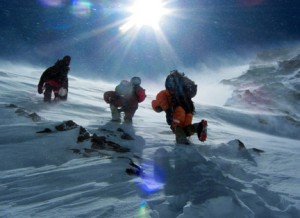 She looked for the tents of her Spanish friends. One climber’s solo tent was still intact, the other, with two climbers, was gone. Frantically she began to dig. An hour later, six feet down, she found it: Santiago Sagaste and Ricardo Valencia were inside, dead. All desire to do anything on Dhaulagiri but get down was gone. Later she poured out her feelings to Ralf. Why didn’t she notice that the weather had turned ominously warm? Why did she ignore the sign when the turquoise bracelet that was her good luck charm broke the day before?
She looked for the tents of her Spanish friends. One climber’s solo tent was still intact, the other, with two climbers, was gone. Frantically she began to dig. An hour later, six feet down, she found it: Santiago Sagaste and Ricardo Valencia were inside, dead. All desire to do anything on Dhaulagiri but get down was gone. Later she poured out her feelings to Ralf. Why didn’t she notice that the weather had turned ominously warm? Why did she ignore the sign when the turquoise bracelet that was her good luck charm broke the day before?
Despite the brush with oblivion, she returned to Dhaulagiri the next year and summited it.
To the Savage Mountain
Just getting to K2 is an arduous journey in its own right, though far easier than it was when the first expeditions traveled for months to reach the peak. I had arranged to accompany the 2011 team to Advanced Base Camp. We all met in the ancient Silk Road city of Kashi, or Kashgar, in the far west of China, and then headed south on June 19 in three Toyota Land Cruisers followed by a truck overloaded with more than two tons of equipment in blue plastic barrels: tents, sleeping bags, stoves, parkas, ice screws, solar panels, batteries, computers, 9,000 feet of rope, 525 eggs, packages of freeze-dried pasta primavera, a bottle of Chivas Regal, a DVD of the movie Hall Pass.
The road skirted the western edge of the Taklimakan Desert and passed through farming towns lined with silver poplars and orchards irrigated by the brawny rivers draining the Kunlun Mountains to the south and the Pamirs to the west. After a night in the dimly lit Yecheng Electricity Hotel we drove over the Chiragsaldi Pass and crept through billows of dust at ten miles an hour until we reached a desolate truck stop called Mazar. In the morning we turned west onto the ragged road that follows the Yarkant River all the way to the Kyrgyz nomad village of Ilik, population 250. We unrolled our sleeping bags in the rug-lined living room of a mud-brick house that belonged to the local mullah. Most of the village turned out in the morning to help lash the expedition’s gear to a herd of camels, and by midday the caravan was heading into the valley of the Surukwat River: 40 camels, eight donkeys, six cows, a small flock of sheep slated for Kyrgyz cooking pots, a Uygur liaison officer named Iskander Abibullah, and six mountaineers in high-tech fabrics and “day for night” sunglasses.
Gerlinde and Ralf were thrilled to be approaching K2 from the north for the first time. The first night in camp Ralf brought out a composite portrait of the mountain made using satellite mapping data and photographs. Maxut studied the daunting details of the North Ridge, which had been first climbed by a Japanese party in 1982; he and Vassiliy had spent many weeks on the ridge in 2007, before bad weather and shortages of food and water forced them to retreat.
“Too soon you show us these,” Maxut said, only half joking. “Hard to sleep now. Where is vodka?”
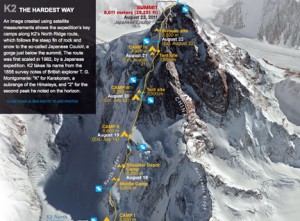 On the third day we crossed Aghil Pass, at 4,780 meters, and descended into the valley of the Shaksgam River, which rises from the glaciers below the Gasherbrum peaks. Giant terraces of mud-packed rock framed a broad, gray stone plain braided with half a dozen or more channels of silty water. The channels didn’t look too hard to cross, until you saw one of the mountain donkeys knocked off all four feet and whisked downstream like a plastic soda bottle. We crossed on the camels.
On the third day we crossed Aghil Pass, at 4,780 meters, and descended into the valley of the Shaksgam River, which rises from the glaciers below the Gasherbrum peaks. Giant terraces of mud-packed rock framed a broad, gray stone plain braided with half a dozen or more channels of silty water. The channels didn’t look too hard to cross, until you saw one of the mountain donkeys knocked off all four feet and whisked downstream like a plastic soda bottle. We crossed on the camels.
On the fifth morning, after an hour of walking, everyone suddenly stopped and stared up at the cloudless sky to the south as if flabbergasted by a UFO. There it was: K2, a colossus erupting out of the earth, its ice-draped walls shimmering in the morning sun like a mirage. It seemed unreal, and yet even from miles off its power was palpable. It was easy to understand the allure it held for mountaineers, no matter that its beauty was imbued with death and its frozen flanks were full of bones and buried bodies. And just as easy to understand why armchair mountaineers might shrink from the thing in dread, and wonder about the balance of reason and desire in those determined to climb it.
Gerlinde, who’d seen K2 many times from the south, sat down on a rock and gazed at the peak with what seemed a welter of emotion in her eyes.
Not wanting to intrude, I asked many weeks later what she’d been thinking about.
“I was thinking, What can I expect this time? How will it be?”
Her K2 history was shadowed with hard memories. She had made three expeditions to the southern side—the last in 2010. On the trip, after a rockfall above Camp III turned Ralf back, Gerlinde joined forces with a close friend of theirs, Fredrik Ericsson, an extreme skier who was attempting ski descents of the world’s highest peaks. Carrying his skis in his pack, Fredrik set out with Gerlinde for the summit from Camp IV. At the base of the steep gully known as the Bottleneck he stopped to set a piton, and as he was hammering it, he lost his footing. He plunged past Gerlinde in an instant and was gone.
In shock, she climbed down as far as she could but found only a ski before the slope vanished into the misty void. Fredrik’s body was later spotted in the snow 3,000 feet below the Bottleneck. He was 35.
As had been the case with the tragedy on Dhaulagiri, Gerlinde wanted nothing to do with K2 after Fredrik’s death. Numb, sad, disillusioned with the price of the life she’d chosen, she went home. At the end of the year she and Ralf took a vacation in Thailand. For four weeks they lived by the sea. They ate fresh fish. They climbed on sea cliffs where falls ended in warm, green water.
People had always asked her why she kept going back to K2. For a long time she didn’t have an answer. But gradually she began to think it wasn’t the mountain’s fault that Fredrik had died. The loss was savage but not the mountain. “The mountain is the mountain, and we are the people who go there,” she says. Friends took a picture of beach stones arranged in the shape of a heart around a message they’d written with pebbles:
Gerlinde + Ralf K2 2011
She used a print of it for the cover of her packing list.
One With the Universe
 Around 7 a.m., Monday, August 22, Gerlinde, Vassiliy, Maxut, and Dariusz set out from Camp IV for a place that was as much the culmination of a common dream as a crowning point of Earth. It was a cloudless day, the weather like a gift. They were climbing up a steep chute of ice, the so-called Japanese Couloir, the predominant feature high on the mountain’s north face. But with only a third of the oxygen at sea level, snow up to their chests in places, and stinging blasts of spindrift that forced them to stop and avert their faces, they made painfully slow progress. By 1 p.m. they had gained less than 180 meters.
Around 7 a.m., Monday, August 22, Gerlinde, Vassiliy, Maxut, and Dariusz set out from Camp IV for a place that was as much the culmination of a common dream as a crowning point of Earth. It was a cloudless day, the weather like a gift. They were climbing up a steep chute of ice, the so-called Japanese Couloir, the predominant feature high on the mountain’s north face. But with only a third of the oxygen at sea level, snow up to their chests in places, and stinging blasts of spindrift that forced them to stop and avert their faces, they made painfully slow progress. By 1 p.m. they had gained less than 180 meters.
Although they’d spent time above Camp IV in 2007, Vassiliy and Maxut were unfamiliar with the Japanese Couloir, and the way up was difficult to see. Gerlinde reached Ralf on the radio at Advanced Base Camp. Since turning back above Camp I, he had devoted himself to supporting the summit party, passing on weather forecasts, advice, and encouragement. Though miles away, he could see that the best place to cross the couloir was below the lip of a long, thin crevasse that ran the width of the slope, where the snow tended to be not as deep and the natural fracture in the slope would lessen the chance of the climbers triggering an avalanche. He helped guide them to the crevasse and watched as their figures, no bigger than commas on a page of paper, began edging across the couloir under a series of seracs—bulges of ice that protruded from the 45-degree slope like dormers from a roof. The seracs might protect them if avalanches swept down from above.
Nearing the rocky left edge, they turned to ascend directly up the slope until they came to a final serac at around 8,300 meters. They’d been climbing for 12 hours; they were 300 meters below the summit.
On the radio Ralf urged Gerlinde to return to Camp IV for the night now that they had broken the trail and knew the way.
“You cannot sleep there, you cannot relax,” he said.
“Ralf,” said Gerlinde, “we are here. We don’t want to go back.”
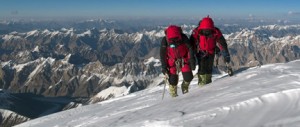 They had known when they set out that morning that their only chance for the summit might require a bivouac. The possibility had prompted Gerlinde to add the extra weight of a three-pound, two-person tent to her rucksack, as well as a pot and stove, and the same tacit understanding had prompted Dariusz, Maxut, and Vassiliy to tuck extra stove-gas canisters and food into their rucksacks. Days later Maxut tried to explain their state of mind to Tommy. “This was the limit,” he said, tracing a line on the ground with his boot, “and this was how far we went beyond it.” He put his boot half a yard beyond the line. “We completely passed the limit. I risked everything, even my family, my wife, my son, my daughter, everything.”
They had known when they set out that morning that their only chance for the summit might require a bivouac. The possibility had prompted Gerlinde to add the extra weight of a three-pound, two-person tent to her rucksack, as well as a pot and stove, and the same tacit understanding had prompted Dariusz, Maxut, and Vassiliy to tuck extra stove-gas canisters and food into their rucksacks. Days later Maxut tried to explain their state of mind to Tommy. “This was the limit,” he said, tracing a line on the ground with his boot, “and this was how far we went beyond it.” He put his boot half a yard beyond the line. “We completely passed the limit. I risked everything, even my family, my wife, my son, my daughter, everything.”
With the sun low in the west, they stopped in the lee of the last serac to prepare a site for the tiny tent. For an hour and 20 minutes they hacked at the ice, until they had a level platform four feet wide, five feet long. They anchored the tent with two ice screws and a pair of ice axes. By 8:15 they were all inside, sitting on their rucksacks, a stove hanging from the ceiling with a pot of melting snow. Gerlinde made some tomato soup. The temperature was minus 13 Fahrenheit. The plan was to rest until midnight, then resume the push for the prize, now so close.
At one in the morning Vassiliy, Maxut, and Gerlinde strapped on their crampons and by the light of their headlamps started up the steep grade above the tent. Dariusz was still inside getting ready. Gerlinde swung her arms in big circles, but she couldn’t feel her fingers, and she was having trouble unclipping from the rope. Maxut’s feet felt like blocks of ice. They retreated to the tent to try to get warm and wait for sunrise. Gerlinde shivered uncontrollably. It was hard to believe that eight weeks earlier they had all been sweltering in 100-degree temperatures in the Shaksgam Valley, and Maxut had been rubbing yogurt on his sunburned legs.
They set out again around 7 a.m. as another immaculate morning dawned. It was now or never. In her rucksack Gerlinde had spare batteries, extra mittens, toilet paper, a second pair of sunglasses, bandages, drops for snow blindness, cortisone, a syringe; for her main sponsor she also carried a flag with the name of an Austrian oil company. For herself, she had a tiny copper box containing a figure of the Buddha, which she planned to bury on the summit. Inside her suit she tucked the half liter of water she had managed to melt; in her pack it would freeze.
They worked their way up the slope toward a 130-meter ramp of snow that angled up to the summit ridge. They were still suffering from the cold but by 11 a.m. could see they would soon be in the sun. At 3 p.m. they reached the base of the ramp. For the first 20 meters they were exhilarated to discover they sank only to their shins. But soon the snow was chest deep. Where they had switched leads to break trail every 50 steps, they now had to switch every 10, with Maxut and Vassiliy taking extra turns. Oh my God, Gerlinde thought, it’s not possible that we’ve come so far up and will have to turn back.
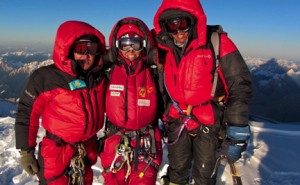 Desperate for an easier way, they stopped climbing in single file at one point. From below, Ralf was astonished to see their track split into three lines as Gerlinde, Vassiliy, and Maxut searched for better footing. Ahead lay a band of snow-patched rocks tilted at 60 degrees. Steep as it was, it proved easier to negotiate. Climbing single file again, Gerlinde changed places with Vassiliy and sank only up to her knees. With a surge of energy and hope she clambered out of the ramp and onto the ridge, where the wind-packed snow was like a sidewalk. It was 4:35 p.m. She could see the summit dome.
Desperate for an easier way, they stopped climbing in single file at one point. From below, Ralf was astonished to see their track split into three lines as Gerlinde, Vassiliy, and Maxut searched for better footing. Ahead lay a band of snow-patched rocks tilted at 60 degrees. Steep as it was, it proved easier to negotiate. Climbing single file again, Gerlinde changed places with Vassiliy and sank only up to her knees. With a surge of energy and hope she clambered out of the ramp and onto the ridge, where the wind-packed snow was like a sidewalk. It was 4:35 p.m. She could see the summit dome.
“You can make it!” Ralf cried over the radio. “You can make it! But you are late! Take care!”
She sipped from her water bottle. Her throat was cracked; it hurt to swallow. It was too cold to sweat, but they were all getting dehydrated just from panting for air.
When Vassiliy caught up, he said she should go on to the summit, he would wait for Maxut. Like Gerlinde, he and Maxut stood on the brink of the only 8,000-meter summit they hadn’t climbed. He wanted to go to the top beside his partner but didn’t want people to think he couldn’t have gotten there as quickly as Gerlinde. “You have to say I waited for Maxut,” he told her.
“Yes, of course,” she said.
And then she walked the final steps to the apex of K2.
It was 6:18 p.m. She wanted to share the moment with Ralf, but when she opened the radio she couldn’t speak. There were mountains in every direction. Mountains she had climbed. Mountains that had stolen the lives of her friends and nearly claimed hers too. But never had she invested so much in a mountain as the one under her boots at last. Alone, with the world at her feet, she turned from one point of the compass to another.
“It was one of the most powerful experiences of my life,” she said later. “I felt as if I were one with the universe. It was so strange on one hand to be extremely exhausted and on the other to be getting so much energy from the view.”
Fifteen minutes later Maxut and Vassiliy arrived, shoulder to shoulder. Everyone embraced. Half an hour later Dariusz staggered up, his hands suffering from having taken his gloves off to change batteries on the video camera. It was 7 p.m. Their shadows reached far across the top of K2, as the pyramidal shadow of the mountain itself reached for miles to the east, and a beautiful golden light began to burnish the world. Dariusz filmed as Gerlinde tried to articulate what it meant to her to be there at that moment: “I’m so deeply filled to stand here now after so many tries, so many years.” She began to cry, then composed herself. “It was very, very hard, all the days now, and now it’s just amazing. I don’t find the right words.” She gestured to the sea of peaks in all directions. “You see all this—I think everybody can understand why we do this.”
Stand With Us
Ralf was up most of the night monitoring the descent. More than a third of all fatalities on K2 have happened on the way down. Around 8:30 p.m. he could see four tiny pinpricks of light moving down the ramp into the Japanese Couloir. As she descended in the dark, exhausted, Gerlinde found herself repeating a phrase that had been in her mind: Steh uns bei und beschütze uns. Stand with us and protect us.
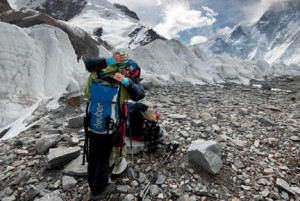 “We spoke many times on the descent,” said Gerlinde. “We asked each other again and again, ‘Is everything OK?’ It was just a very serious, very exacting climb. If there would have been just the cold, it would have been hard enough. But there was the steepness, the altitude, the wind during the night and the morning, and the psychological effects—we didn’t have any rope left to fix the route, and the terrain was very steep and exposed. Everybody had to take a very long time and be very careful how they moved.”
“We spoke many times on the descent,” said Gerlinde. “We asked each other again and again, ‘Is everything OK?’ It was just a very serious, very exacting climb. If there would have been just the cold, it would have been hard enough. But there was the steepness, the altitude, the wind during the night and the morning, and the psychological effects—we didn’t have any rope left to fix the route, and the terrain was very steep and exposed. Everybody had to take a very long time and be very careful how they moved.”
Two days later, when Gerlinde came down from Camp I, Ralf met her on the glacier. They held each other for a long time. At Camp I she had found the letter he had left for her in the hope that she would return—a four-foot-long missive written on toilet paper avowing his love and explaining his decision to turn back. “I don’t always want to be the person who holds you back…”
In base camp Gerlinde spoke by satellite phone to Fredrik’s father, Jan Olaf Ericsson, who wanted to know everything she had seen from the summit of the mountain where his son was buried. The president of Austria called to congratulate her. The prime minister of Kazakhstan congratulated Maxut and Vassiliy on Twitter. In the dining tent Gerlinde fell asleep over a plate of watermelon.
At the airport in Munich her whole family turned out to greet her. Her father cried when he hugged her, and for the first time he did not say she’d climbed enough mountains and should stop.
With hardly an ounce of fat to start with, she’d lost 17 pounds. At a ceremony in Bühl, Germany, Gerlinde was showered with bouquets and gifts, including a jeroboam of red Rhine wine labeled with a picture of her atop K2 with her arms over her head. “Normally you will not find me with my arms over my head,” she says. “It’s not that I felt like a queen, but that I wanted to hug the whole world.”
Her friend and fellow climber David Göttler had arrived in Bühl from Munich to help edit the video of the climb for the lectures she would give. He tried several different pieces of music for the crucial summit scene, but none worked as well as “Ára bátur” by the Icelandic band Sigur Rós. He arranged the pictures and footage so the chorus of angelic voices and symphonic strings and horns all came to a crescendo just as Gerlinde thrust her arms overhead at the summit. He showed it to Ralf, who was thrilled by how powerfully it conveyed the glory of Gerlinde’s triumph.
But when they showed it to Gerlinde, she frowned and shook her head.
“No, Ralf, it’s too much. I’m sorry, David. I think it’s too much.”
They protested, to no avail. Then David, who had attempted K2 with Gerlinde in 2009 and knew her well, began to rework the scene. The pictures were the same. The music was the same. But the effect was completely different. The flow of photographs that ended with the climactic picture of Gerlinde’s upraised arms had been altered so that the crescendo of the music did not proclaim the glory of one mountaineer that sundown hour on the summit of K2 but the great world she could see all around her, transfigured in golden light.
She smiled when she saw it.
–Chip Brown (National Geographic / Author).
–Tommy Heinrich (Photography)
Reach New Heights with Deuter!
